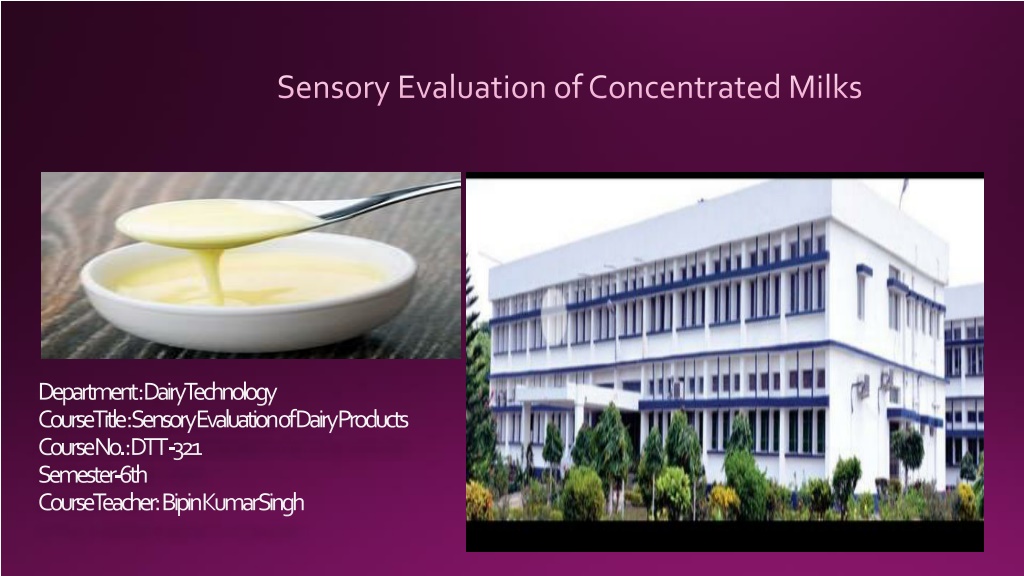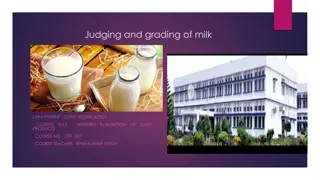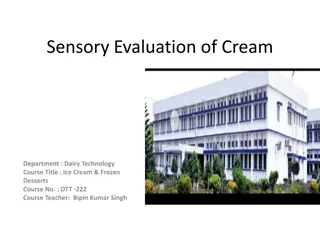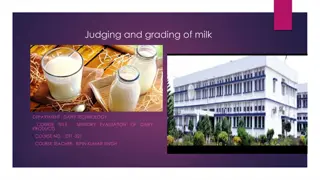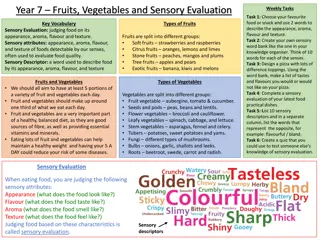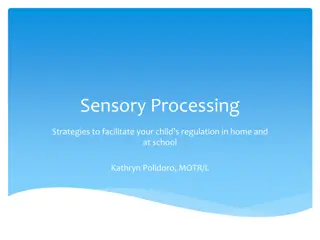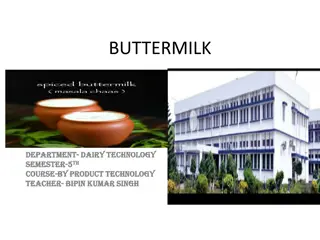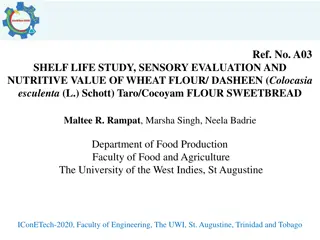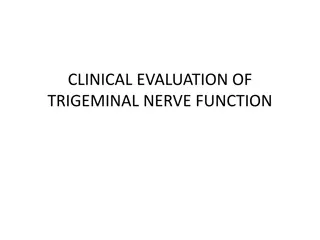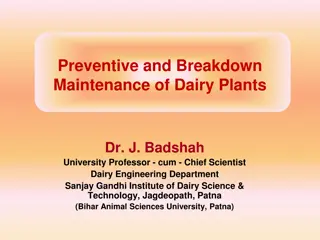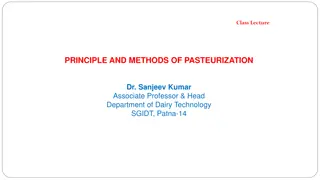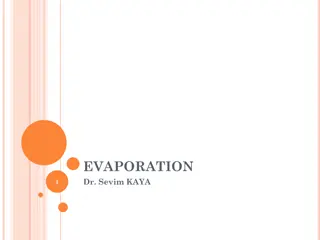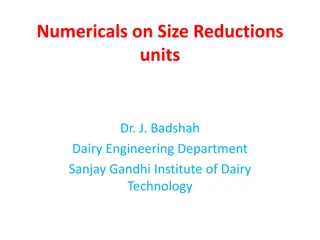Sensory Evaluation of Concentrated Milks in Dairy Technology
A comprehensive look into the sensory evaluation of concentrated milks in the dairy industry, focusing on the examination process of evaporated milk. Understanding the sensory attributes is crucial for product improvement and ensuring quality for consumers. The process involves assessing color, texture, flavor, and examining cans for quality indicators like appearance, viscosity, and uniformity. Attention to detail is necessary to identify any defects that may affect the final product.
Download Presentation

Please find below an Image/Link to download the presentation.
The content on the website is provided AS IS for your information and personal use only. It may not be sold, licensed, or shared on other websites without obtaining consent from the author. Download presentation by click this link. If you encounter any issues during the download, it is possible that the publisher has removed the file from their server.
E N D
Presentation Transcript
Sensory Evaluation of Concentrated Milks Department:DairyTechnology CourseTitle:SensoryEvaluationofDairyProducts CourseNo.:DTT-321 Semester-6th CourseTeacher:BipinKumarSingh
INTRODUCTION A thorough understanding of the sensory attributes of concentrated milk and their routine examination is imperative, not only to assure improvement of the product, but also for ensuring that the product reaches theconsumer in good condition.
EVAPORATED MILK When judging or grading evaporated milk, the judge must keep in mind the desirable qualities and standards for the product. It must be noted that, in addition to meeting the legal chemical requirements for the product high quality evaporated milk must be white to creamy in colour, have a relatively viscous body, be uniformly smooth in texture and possess a mild, pleasant flavour.
Procedure for examination A routine in examining cans of evaporated milk facilitates judging of the samples. The following steps have been found to be of material aid in going over a lot of samples.
Precaution Examine the cans for appearance, noticethe upper end of the can for polish; observe the neatness ofthe label. Openthe canin suchaway the boththecanandcontents maybe examined. Notice the colour of the milk whichshould be uniformly white to cream colour. Intensity of darkening may be notedfor its degree e.g. none, slight, distinct and pronounced. Study the body and texture. Smooth,relatively viscous evaporated milk pours like a thin cream without marked splashing. Allowthe can to drain well. Look for anydeposit which maybe present inthe bottomofthe can. Should the milk lack uniformity try todetermine whether the chief factor is fat, protein, salts or foreign material?In case the fat is responsible, the defect will appear at the top of the can asa cream layer or as buttery particles. Defect due to protein will appear asvarious size curds distributed throughout or as different intensities ofgelation.
Contd.. Observe the condition of the container looking for splangling, blackening of the seam and rusting of the container. Splanging appears as clean, bright, dark, overlapping blotches on the surface as though the tin wereattacked byacid. Determine the colour reaction in coffee. It should be a rich, golden brown colour. Off flavour may be associated with rust formation in the container. Note the miscibility with coffee. Feathering in hot coffee appears as finely divided, serrated curds shortly after the evaporated milk has beenadded slowly to the hot coffee.
Defects in evaporated milk Flavour The flavour defects which may occur inevaporated milk are usually unlike those commonly occurring in fresh milk.Probably the most common flavour defect in evaporated milk is that which seemsto be associated with progressive age darkening or browning of the product.Terms such as slightly acid, 'stale coffee, old, sour 'and strong suggest thenature of the defect. The caramel flavour connotes a pleasant, appetizing tastesensation which is definitely lacking in the defect associated withage-darkening of evaporated milk. This flavour defect is easily detected. The off-flavour is accompanied by only aslight odour suggestingstaleness.The underlyingtaste reactionof the agedarkened evaporated milkisacid. Body and texture Freshevaporated milk is remarkably free of body and texture defects. However, whenevaporated milk is held for a long period of time or under adverse conditions,the following body and texture defects may be encountered: Buttery/fat separation :This defect appears as a layer (up to 1 cm or more thick) of heavy cream at thetop of the can. Among the causes of this defect are inadequate homogenization,high storage temperature, longstorage periodand improperhandling whileinstorage. Curdy: Curdy evaporated milk may be noted by the presence of many coagulated particlesinterspersed throughout the milk or by a continuous mass of coagulum. It ischiefly associated with the protein rather than the fat. It is a seriouseconomic defect. This condition is due mainly to the abnormally low heatcoagulation pointof the endproduct and couldnot withstand the sterilizationprocess.
Contd.. Feathering :The feathering of evaporated milk in hot coffee cannot be foretold by macroscopic examination but by actually testing the milk in hot coffee.' It has been postulated that the formation of curd when evaporated milk is added to coffee is due entirely to an excess of viscosity Gassy :Gassy evaporated milk is rather uncommon. The defect is manifest by bulged cans and sometimes by a hissing sound of escaping air whenthecanis punctured. Grainy: A grainy evaporated milk is the one lacking smoothness and uniformity throughout. Such milk seems coarse. It is often associated with an excessively heavy, viscous body. The judge must be are in mind that grainy evaporated milk does not actually contain "grams of sediment settled in the container. Neither does such milk contain curds orlumpsofbutter.
Contd Low viscosity :A low viscosity evaporated milk may be noted by its milk like consistency. This defect is discriminated against as it denotes inadequatecondensation. Sediment :The sediment resulting from settling of leukocytes, disintegrated cells, denatured 'protein and foreign material of more or less of a colloidal nature is usually darker in colour than the evaporated milk since this sediment is readily miscible it may be seen only when a can, undisturbedfor sometime,isemptiedslowly. Colour In judging evaporated milk two possible colour defects may be encountered, viz. too light in colour and too dark in colour. Too light colour is not it serious defect although it is not desired. The brown discolouration in evaporated milk associated with high sterilization temperature, high storage temperature andage is a serious defect in evaporatedmilk.
Sweetened condensed milk Since sweetened condensed milk contains a sufficiently high percentage of sugar for its pronouncedly sweet. Beyond this intense sweetness, the flavour should be clean and pleasant with a slight trace of mild caramel as an aftertaste. preservation, the flavour is
Procedure for examination A definite routine enables the judge tomake the best use of the available time with the assurancethattheexaminationiscompletewhenfinished. Appearance of the containershould be asbright as new tin as the canhas not been subjected to the highheattreatmentof sterilization. The surface of the product should havethe same intensity of colour as the under layer and shouldbe uniforminconsistencywithnoindicationoflumps,free fatorscreenformation. Colour of the product should be uniformthroughout. Observe if the milk has a greenish white creamy orabrownishcolour. Viscosity desired is one which isobviously not "thin" but resembling to a marked degree that of mediumto heavy molasses. In grading sweetened condensed milk, the judge must bear inmind that a desirable sweetened condensed milk pours like molasses and, whenpoured, seeks its own levelleavingnotraceofthe foldsonthe surface. Flavour should be observed both for thetextural and taste sensations. Register the relative smoothness of the productas a whole and the fineness of the grain by pressing the sample againstthepalatewith thetongue.
Defects of sweetened condensed milk Metallic - Prepare 0.5 percent solution of ferrous sulphate in distilled water. Add 1, 4 and 7 ml of the solution to 100 g fresh sweetened condensed milk and mixwell tosimulate varying degrees ofmetallic flavourinit. Rancid -Homogenize 30 percent fat cream obtained from raw milk, allow it to stay at about 37 C for about 1 hour before heating it to nearly 75 C and immediately cooling it to room temperature. Mix the cream with fresh sweetened condensed milk at the rate of 10, 20 and 50 percent to obtain varying degrees ofrancidity in the product. Strong, caramel - Heat, in a boiling water bath, fresh sweetened condensed milk (70 to 80 g) to 85-90 C and leave it covered at about 90 C for 2+, 34 and 44 hours, before cooling to room temperature. This will also give varying degrees ofbrowning in in the product. Tallowy - Expose fresh sweetened condensed milk, containing approximately 5 mg/kg of ferric or cupric chloride to sunlight to varying periods such as 3, 6 and9hours.
Contd.. Sandy, course, mealy - Heat the fresh sample ( about 200 g ) in a beaker at about 70 C for 5 minutes and hold it undisturbed in an incubator at 30 C for 6, 12 and 18 hours to manipulate different degrees ofsandiness in the product. Settled-Heat the sample as mentioned in (e) above and maintain in an incubator at 30 C for 24, 48 and 72 hours. Thickened - For developing varying degrees of the defect, heat a fresh sample of condensed milk in a water bath to 80 C. As an alternative for developing this defect packed commodities samples of tins can be stored at 37 C for a period varying between 30 to 90 days.
Score card for Sweetened Condensed Milk EVALUATION CARD FOR SWEETENED CONDENSED MILK ( Clauses 6.3 and 6.4) Name . . . . . . . . . . . . . . . . . . . . . . . . . . . . . . . . . . . . . . . . . . . . . . . . . . . . . . . . . . Date. . . . . . . . . . . . . . . . . . . . . . . . . . . . . . . . . . . . . . . . . . . Code No. . . . . . . . . . . . . . . . . . . . . . . . . . . . . . . . . . . . . . . . . . . . . . . . . . . . ..Time . . . . . . . . . . . . . . . . . ._. . . . .. . . . . . . . . . . . . . . . A) Score the sample for different characteristics. Indicate the degree of defects, if any, encircling the applicable one and deduct accordingly from the characteristic score.
Grading After computation of data, recorded in Table by the panelists, the following grades should be awarded. Score Grades 90 and above Excellent 80-89 Good 60-79 Fair 59 and below Poor
